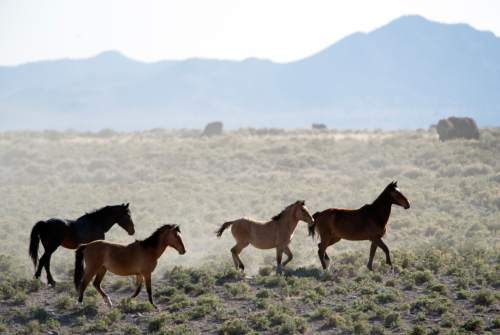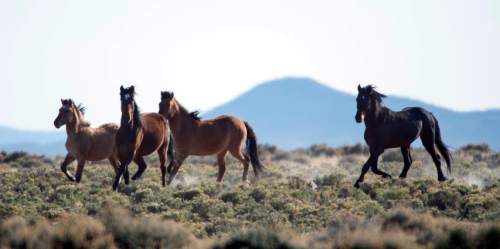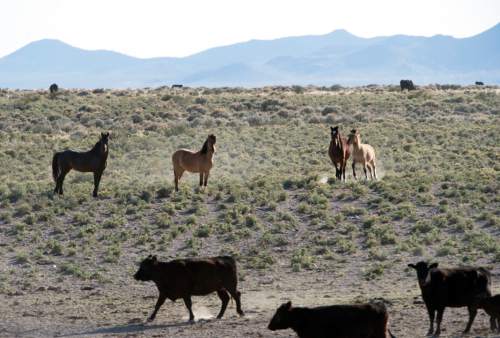This is an archived article that was published on sltrib.com in 2014, and information in the article may be outdated. It is provided only for personal research purposes and may not be reprinted.
The federal Bureau of Land Management will likely clear most if not all the wild horses from a West Desert block of state land in July as part of a newly approved plan to remove 200 wild horses from Utah rangelands this year.
The Interior Department this week greenlighted Utah BLM's request to gather these horses in the face of mounting pressure from state and local officials concerned that overpopulation of wild horses is damaging a parched range and could force ranchers to reduce cattle grazing levels.
"It's a bittersweet thing to me," said Beaver County Commissioner Mark Whitney. "Juan [Palma, BLM's state director] means well, but it's only a drop in the bucket in what needs to be done in the West Desert because they've let the problem get so out of control, especially in drought conditions."
BLM's plan calls for rounding up 140 horses on the Blawn Wash herd area that overlies 26,000 acres overseen by the School and Institutional Trust Lands Administration (SITLA) west of Milford.
Blawn Wash has been a source of tension for state trust lands managers who amassed this block of rangelands several years ago with the expectation that horses would no longer be allowed to graze them, according to Kim Christy, SITLA's associate director.
"This goes beyond revenue generation. This is a severe resource degradation issue that's attributable to overstocking of horses," Kristy said.
SITLA's Blawn Wash holdings cover 2,000 animal-unit months, or AUMs — the amount of forage that support a cow-calf pair for one month.
"For the three grazing permittees, it's vital for their survival," Kristy said.
Under the new authorization, another 50 "nuisance" horses are to be trapped in corrals on private lands, and ten more are to be removed from public lands in Beaver County because they hang around State Route 21, posing a threat to traffic safety, according to BLM spokeswoman Megan Crandall. These numbers include the eight that have already been trapped on private ranch lands this spring.
The Blawn Wash gather is part of a string of West Desert roundups undergoing an environmental assessment. This proposal envisions the removal of 600 to 700 horses, mostly from the Bible Spring Complex in western Iron County. This would be accomplished in four roundups over the next 10 years.
"Our end goal is to reach AML (appropriate management level) but that's going to take time, probably years," Crandall said. "This 200 is going to constructively move us forward to addressing that situation."
But horse advocates doubted these roundups will ever resolve the horse question nagging Utah and other Western states.
"They are continuing the same unsustainable and broken approach," said Suzanne Roy of the American Wild Horse Preservation Campaign. "Removing horses from the range, warehousing them in holding facilities, and not using fertility control. It would be far cheaper to persuade ranchers to not graze in [wild horse] herd management areas."
On Friday and Saturday, BLM is hosting public adoptions at its horse facilities in Delta and Cedar City. Learn more at http://on.doi.gov/1lFiu3h.











